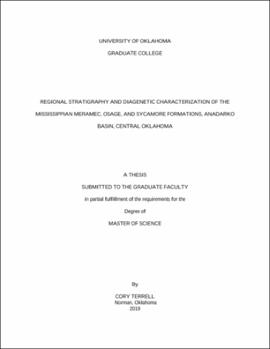| dc.description.abstract | The principal goals of this study were to characterize the regional stratigraphy, analyze the extent of diagenetic alteration, and determine the factors controlling reservoir quality of the Meramec, Osage, and Sycamore Formations in the STACK (Sooner Trend of the Anadarko Basin in Canadian and Kingfisher counties), MERGE, and SCOOP (South Central Oklahoma Oil Province). These formations are poorly understood unconventional targets in the Anadarko Basin that overlie the Devonian to Mississippian Woodford Shale. The Mississippian Meramec, Osage, and Sycamore formations are composed of low permeability anisotropic siliciclastics and carbonate rocks with limited source potential and storage capacity.
Regional well log correlations, petrographic analysis, core descriptions, anisotropy of magnetic susceptibility, and hand-held X-Ray fluorescence spectroscopy (HHXRF) was used to characterize the spatial and temporal relationships of the regional Mississippian stratigraphy within the study area. From this analysis, it was concluded that the lower portions of the Sycamore (Sycamore Limestone) in the SCOOP are the time equivalent of the Osage in the STACK. This work also showed that the upper portions of the Sycamore (Sycamore Shale) is the time equivalent of the STACK Meramec. These trends also point to a northern Osage source and a southern Sycamore Limestone source.
Petrophysical analysis, HHXRF, petrographic relationships were integrated to determine that reservoir quality is lithology dependent. Marine calcite cements have occluded primary porosity within siltstones in the Meramec, Osage, and Sycamore Formations that lack detrital clay influx or bioturbation. Increased clay content prevents calcite nucleation and can preserve primary porosity as well as provide interlayer clay porosity. Porosity within the Osage and Sycamore Limestone Formations are locally enhanced as a result of meteoric diagenesis. Local sea level fluctuations decalcified carbonates and developed enhanced secondary porosity. The Sycamore Limestone and Osage both contain fractures with hydrothermal minerals such as mega quartz and baroque dolomite that developed coeval with hydrocarbon migration. | en_US |
